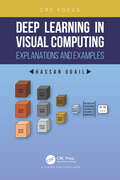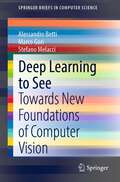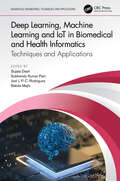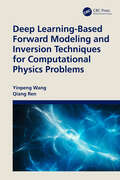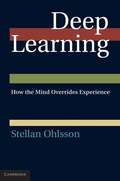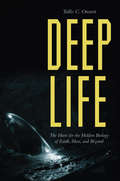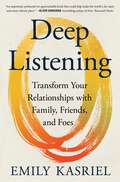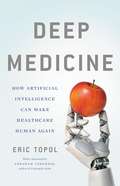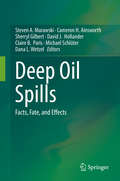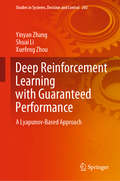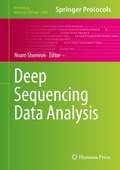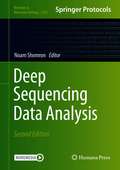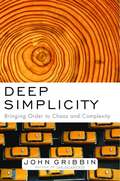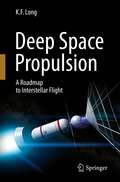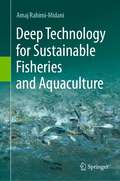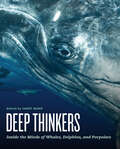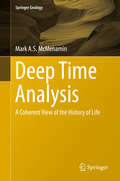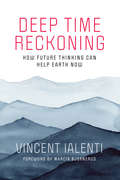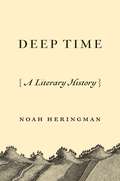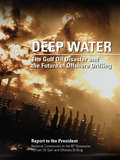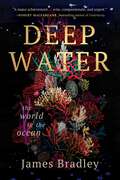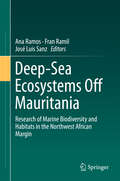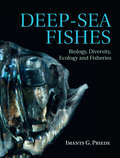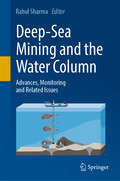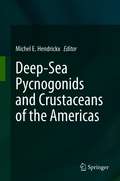- Table View
- List View
Deep Learning in Visual Computing: Explanations and Examples
by Hassan UgailDeep learning is an artificially intelligent entity that teaches itself and can be utilized to make predictions. Deep learning mimics the human brain and provides learned solutions addressing many challenging problems in the area of visual computing. From object recognition to image classification for diagnostics, deep learning has shown the power of artificial deep neural networks in solving real world visual computing problems with super-human accuracy. The introduction of deep learning into the field of visual computing has meant to be the death of most of the traditional image processing and computer vision techniques. Today, deep learning is considered to be the most powerful, accurate, efficient and effective method with the potential to solve many of the most challenging problems in visual computing. This book provides an insight into deep machine learning and the challenges in visual computing to tackle the novel method of machine learning. It introduces readers to the world of deep neural network architectures with easy-to-understand explanations. From face recognition to image classification for diagnosis of cancer, the book provides unique examples of solved problems in applied visual computing using deep learning. Interested and enthusiastic readers of modern machine learning methods will find this book easy to follow. They will find it a handy guide for designing and implementing their own projects in the field of visual computing.
Deep Learning to See: Towards New Foundations of Computer Vision (SpringerBriefs in Computer Science)
by Marco Gori Alessandro Betti Stefano MelacciThe remarkable progress in computer vision over the last few years is, by and large, attributed to deep learning, fueled by the availability of huge sets of labeled data, and paired with the explosive growth of the GPU paradigm. While subscribing to this view, this work criticizes the supposed scientific progress in the field, and proposes the investigation of vision within the framework of information-based laws of nature. This work poses fundamental questions about vision that remain far from understood, leading the reader on a journey populated by novel challenges resonating with the foundations of machine learning. The central thesis proposed is that for a deeper understanding of visual computational processes, it is necessary to look beyond the applications of general purpose machine learning algorithms, and focus instead on appropriate learning theories that take into account the spatiotemporal nature of the visual signal.Serving to inspire and stimulate critical reflection and discussion, yet requiring no prior advanced technical knowledge, the text can naturally be paired with classic textbooks on computer vision to better frame the current state of the art, open problems, and novel potential solutions. As such, it will be of great benefit to graduate and advanced undergraduate students in computer science, computational neuroscience, physics, and other related disciplines.
Deep Learning, Machine Learning and IoT in Biomedical and Health Informatics: Techniques and Applications (Biomedical Engineering)
by Sujata Dash Joel J. P. C. Rodrigues Subhendu Kumar Pani Babita MajhiBiomedical and Health Informatics is an important field that brings tremendous opportunities and helps address challenges due to an abundance of available biomedical data. This book examines and demonstrates state-of-the-art approaches for IoT and Machine Learning based biomedical and health related applications. This book aims to provide computational methods for accumulating, updating and changing knowledge in intelligent systems and particularly learning mechanisms that help us to induce knowledge from the data. It is helpful in cases where direct algorithmic solutions are unavailable, there is lack of formal models, or the knowledge about the application domain is inadequately defined. In the future IoT has the impending capability to change the way we work and live. These computing methods also play a significant role in design and optimization in diverse engineering disciplines. With the influence and the development of the IoT concept, the need for AI (artificial intelligence) techniques has become more significant than ever. The aim of these techniques is to accept imprecision, uncertainties and approximations to get a rapid solution. However, recent advancements in representation of intelligent IoTsystems generate a more intelligent and robust system providing a human interpretable, low-cost, and approximate solution. Intelligent IoT systems have demonstrated great performance to a variety of areas including big data analytics, time series, biomedical and health informatics. This book will be very beneficial for the new researchers and practitioners working in the biomedical and healthcare fields to quickly know the best performing methods. It will also be suitable for a wide range of readers who may not be scientists but who are also interested in the practice of such areas as medical image retrieval, brain image segmentation, among others. • Discusses deep learning, IoT, machine learning, and biomedical data analysis with broad coverage of basic scientific applications • Presents deep learning and the tremendous improvement in accuracy, robustness, and cross- language generalizability it has over conventional approaches • Discusses various techniques of IoT systems for healthcare data analytics • Provides state-of-the-art methods of deep learning, machine learning and IoT in biomedical and health informatics • Focuses more on the application of algorithms in various real life biomedical and engineering problems
Deep Learning-Based Forward Modeling and Inversion Techniques for Computational Physics Problems
by Qiang Ren Yinpeng WangThis book investigates in detail the emerging deep learning (DL) technique in computational physics, assessing its promising potential to substitute conventional numerical solvers for calculating the fields in real-time. After good training, the proposed architecture can resolve both the forward computing and the inverse retrieve problems.Pursuing a holistic perspective, the book includes the following areas. The first chapter discusses the basic DL frameworks. Then, the steady heat conduction problem is solved by the classical U-net in Chapter 2, involving both the passive and active cases. Afterwards, the sophisticated heat flux on a curved surface is reconstructed by the presented Conv-LSTM, exhibiting high accuracy and efficiency. Additionally, a physics-informed DL structure along with a nonlinear mapping module are employed to obtain the space/temperature/time-related thermal conductivity via the transient temperature in Chapter 4. Finally, in Chapter 5, a series of the latest advanced frameworks and the corresponding physics applications are introduced. As deep learning techniques are experiencing vigorous development in computational physics, more people desire related reading materials. This book is intended for graduate students, professional practitioners, and researchers who are interested in DL for computational physics.
Deep Learning: How the Mind Overrides Experience
by Stellan OhlssonAlthough the ability to retain, process, and project prior experience onto future situations is indispensable, the human mind also possesses the ability to override experience and adapt to changing circumstances. Cognitive scientist Stellan Ohlsson analyzes three types of deep, non-monotonic cognitive change: creative insight, adaptation of cognitive skills by learning from errors, and conversion from one belief to another, incompatible belief. For each topic, Ohlsson summarizes past research, re-formulates the relevant research questions, and proposes information-processing mechanisms that answer those questions. The three theories are based on the principles of redistribution of activation, specialization of practical knowledge, and re-subsumption of declarative information. Ohlsson develops the implications of those mechanisms by scaling their effects with respect to time, complexity, and social interaction. The book ends with a unified theory of non-monotonic cognitive change that captures the abstract properties that the three types of change share.
Deep Life: The Hunt for the Hidden Biology of Earth, Mars, and Beyond
by Tullis C. OnstottDeep Life takes readers to uncharted regions deep beneath Earth's crust in search of life in extreme environments and reveals how astonishing new discoveries by geomicrobiologists are helping the quest to find life in the solar system.Tullis Onstott, named one of the 100 most influential people in America by Time magazine, provides an insider's look at the pioneering fieldwork that is shining vital new light on Earth's hidden biology--a thriving subterranean biosphere that scientists once thought to be impossible. Come along on epic descents two miles underground into South African gold mines to experience the challenges that Onstott and his team had to overcome. Join them in their search for microbes in the ancient seabed below the desert floor in the American Southwest, and travel deep beneath the frozen wastelands of the Arctic tundra to discover life as it could exist on Mars.Blending cutting-edge science with thrilling scientific adventure, Deep Life features rare and unusual encounters with exotic life forms, including a bacterium living off radiation and a hermaphroditic troglodytic worm that has changed our understanding of how complex subsurface life can really be. This unforgettable book takes you to the absolute limits of life--the biotic fringe--where today's scientists hope to discover the very origins of life itself.
Deep Listening: Transform Your Relationships with Family, Friends, and Foes
by Emily Kasriel“If you’ve ever felt like two ears aren’t enough, this book is for you. Deep Listening reveals how we can improve at hearing others—and helping them hear us too.” —Adam Grant, #1 New York Times bestselling author of Think Again and Hidden Potential, and host of the podcast Re:ThinkingWhy do so many conversations leave us feeling unheard and disconnected? In Deep Listening, acclaimed BBC journalist, accredited executive coach, and mediator Emily Kasriel argues that it’s because we've forgotten how to truly listen.Distracted by our own agenda, we so often hear without understanding, impatiently waiting for our turn to speak. In this exploration of transformational listening, Kasriel shows how shifting from surface-level exchanges to Deep Listening can enrich our relationships as friends, parents, and partners, enhance our effectiveness as leaders, and strengthen the fabric of our communities. At a time when divisions within communities, organizations, and families are often a source of profound pain, this book offers inspiration and practical guidance on how we can better listen to each other, even when we fiercely disagree.Drawing on scientific studies, new research, and powerful stories from legendary listeners in politics, business, and the arts, Kasriel unveils her simple yet transformative eight-step approach. With Deep Listening as your guide, you’ll learn to become a better family member, friend, co-worker and citizen.At once a practical guide and a heartfelt manifesto, this groundbreaking book challenges us to rethink our approach to listening and in doing so, transform our lives from the inside out. Whether readers seek to strengthen their empathy, boost their performance at work, or foster genuine understanding across cultural, political, and generational divides, Deep Listening provides the tools and inspiration to unlock the power of lasting, meaningful connections.
Deep Medicine: How Artificial Intelligence Can Make Healthcare Human Again
by Eric TopolOne of America's top doctors reveals how AI will empower physicians and revolutionize patient care Medicine has become inhuman, to disastrous effect. The doctor-patient relationship--the heart of medicine--is broken: doctors are too distracted and overwhelmed to truly connect with their patients, and medical errors and misdiagnoses abound. In Deep Medicine, leading physician Eric Topol reveals how artificial intelligence can help. AI has the potential to transform everything doctors do, from notetaking and medical scans to diagnosis and treatment, greatly cutting down the cost of medicine and reducing human mortality. By freeing physicians from the tasks that interfere with human connection, AI will create space for the real healing that takes place between a doctor who can listen and a patient who needs to be heard.Innovative, provocative, and hopeful, Deep Medicine shows us how the awesome power of AI can make medicine better, for all the humans involved.
Deep Oil Spills: Facts, Fate, and Effects
by Steven A. Murawski Cameron H. Ainsworth Sherryl Gilbert David J. Hollander Claire B. Paris Michael Schlüter Dana L. WetzelThe demand for oil and gas has brought exploration and production to unprecedented depths of the world’s oceans. Currently, over 50% of the oil from the Gulf of Mexico now comes from waters in excess of 1,500 meters (one mile) deep, where no oil was produced just 20 years ago. The Deepwater Horizon oil spill blowout did much to change the perception of oil spills as coming just from tanker accidents, train derailments, and pipeline ruptures. In fact, beginning with the Ixtoc 1 spill off Campeche, Mexico in 1979-1980, there have been a series of large spill events originating at the sea bottom and creating a myriad of new environmental and well control challenges. This volume explores the physics, chemistry, sub-surface oil deposition and environmental impacts of deep oil spills. Key lessons learned from the responses to previous deep spills, as well as unresolved scientific questions for additional research are highlighted, all of which are appropriate for governmental regulators, politicians, industry decision-makers, first responders, researchers and students wanting an incisive overview of issues surrounding deep-water oil and gas production.
Deep Reinforcement Learning with Guaranteed Performance: A Lyapunov-Based Approach (Studies in Systems, Decision and Control #265)
by Shuai Li Yinyan Zhang Xuefeng ZhouThis book discusses methods and algorithms for the near-optimal adaptive control of nonlinear systems, including the corresponding theoretical analysis and simulative examples, and presents two innovative methods for the redundancy resolution of redundant manipulators with consideration of parameter uncertainty and periodic disturbances.It also reports on a series of systematic investigations on a near-optimal adaptive control method based on the Taylor expansion, neural networks, estimator design approaches, and the idea of sliding mode control, focusing on the tracking control problem of nonlinear systems under different scenarios. The book culminates with a presentation of two new redundancy resolution methods; one addresses adaptive kinematic control of redundant manipulators, and the other centers on the effect of periodic input disturbance on redundancy resolution.Each self-contained chapter is clearly written, making the book accessible to graduate students as well as academic and industrial researchers in the fields of adaptive and optimal control, robotics, and dynamic neural networks.
Deep Sequencing Data Analysis
by Noam ShomronThe new genetic revolution is fuelled by Deep Sequencing (or Next Generation Sequencing) apparatuses which, in essence, read billions of nucleotides per reaction. Effectively, when carefully planned, any experimental question which can be translated into reading nucleic acids can be applied.In Deep Sequencing Data Analysis, expert researchers in the field detail methods which are now commonly used to study the multi-facet deep sequencing data field. These included techniques for compressing of data generated, Chromatin Immunoprecipitation (ChIP-seq), and various approaches for the identification of sequence variants. Written in the highly successful Methods in Molecular Biology series format, chapters include introductions to their respective topics, lists of necessary materials and reagents, step-by-step, readily reproducible protocols, and key tips on troubleshooting and avoiding known pitfalls. Authoritative and practical, Deep Sequencing Data Analysis seeks to aid scientists in the further understanding key data analysis procedures for deep sequencing data interpretation.
Deep Sequencing Data Analysis (Methods in Molecular Biology #2243)
by Noam ShomronThis second edition provides new and updated chapters from expert researchers in the field detailing methods used to study the multi-facet deep sequencing data field. Chapters guide readers through techniques for processing RNA-seq data, microbiome analysis, deep learning methodologies, and various approaches for the identification of sequence variants. Written in the highly successful Methods in Molecular Biology series format, chapters include introductions to their respective topics, lists of the necessary materials and reagents, step-by-step, readily reproducible laboratory protocols, and tips on troubleshooting and avoiding known pitfalls. Authoritative and cutting-edge, Deep Sequencing Data Analysis: Methods and Protocols, Second Edition aims to ensure successful results in the further study of this vital field.
Deep Simplicity: Bringing Order to Chaos and Complexity
by John GribbinOver the past two decades, no field of scientific inquiry has had a more striking impact across a wide array of disciplines–from biology to physics, computing to meteorology–than that known as chaos and complexity, the study of complex systems. Now astrophysicist John Gribbin draws on his expertise to explore, in prose that communicates not only the wonder but the substance of cutting-edge science, the principles behind chaos and complexity. He reveals the remarkable ways these two revolutionary theories have been applied over the last twenty years to explain all sorts of phenomena–from weather patterns to mass extinctions. <p><p> Grounding these paradigm-shifting ideas in their historical context, Gribbin also traces their development from Newton to Darwin to Lorenz, Prigogine, and Lovelock, demonstrating how–far from overturning all that has gone before–chaos and complexity are the triumphant extensions of simple scientific laws. Ultimately, Gribbin illustrates how chaos and complexity permeate the universe on every scale, governing the evolution of life and galaxies alike.
Deep Space Propulsion
by K. F. LongThe technology of the next few decades could possibly allow us to explore with robotic probes the closest stars outside our Solar System, and maybe even observe some of the recently discovered planets circling these stars. This book looks at the reasons for exploring our stellar neighbors and at the technologies we are developing to build space probes that can traverse the enormous distances between the stars. In order to reach the nearest stars, we must first develop a propulsion technology that would take our robotic probes there in a reasonable time. Such propulsion technology has radically different requirements from conventional chemical rockets, because of the enormous distances that must be crossed. Surprisingly, many propulsion schemes for interstellar travel have been suggested and await only practical engineering solutions and the political will to make them a reality. This is a result of the tremendous advances in astrophysics that have been made in recent decades and the perseverance and imagination of tenacious theoretical physicists. This book explores these different propulsion schemes - all based on current physics - and the challenges they present to physicists, engineers, and space exploration entrepreneurs. This book will be helpful to anyone who really wants to understand the principles behind and likely future course of interstellar travel and who wants to recognizes the distinctions between pure fantasy (such as Star Trek's 'warp drive') and methods that are grounded in real physics and offer practical technological solutions for exploring the stars in the decades to come.
Deep Technology for Sustainable Fisheries and Aquaculture
by Amaj Rahimi-MidaniThis book uses real-world examples from the aquaculture industry to demonstrate how deep technology is assisting farmers and vulnerable communities. Works conducted by Poseidon-AI (a deep tech company involved in the aquaculture sector) in different countries are presented as case studies to show the positive impacts of deep tech involvement in the aquaculture sector. Primary industries, such as fisheries and aquaculture, rely heavily on labor. Furthermore, the manual practices of these farming methods increase material waste and reduce yields, resulting in higher costs and lower revenues. Poikilotherms make up the majority of aquatic animals, and environmental changes have a significant impact on them. This means that, due to climate change, farming of these animals cannot continue in the same way that it has for centuries. Artificial intelligence, machine learning, image processing, sensing, and automation are approaches that can assist these farms in dealing with rapid environmental changes while also assisting farmers in growing their businesses sustainably. This book is of interest to climate change scientists, entrepreneurs, investors, civil workers, and policymakers. Furthermore, the book is a great complimentary material for graduate students of fisheries, aquaculture, ecology, soil science, water management and environmental sciences. All national and international policymakers working in implementation of UNSDGs and sustainability, will find this book a useful read.
Deep Thinkers: Inside the Minds of Whales, Dolphins, and Porpoises
by Janet MannHumans aside, dolphins, whales, and porpoises are often considered to be the smartest creatures on Earth. Science and nature buffs are drawn to stories of their use of tools, their self-recognition, their beautiful and complex songs, and their intricate societies. But how do we know what we know, and what does it mean? In Deep Thinkers, renowned cetacean biologist Janet Mann gathers a gam of the world’s leading whale and dolphin researchers—including Luke Rendell, Hal Whitehead, and many more—to illuminate these vital questions, exploring the astounding capacities of cetacean brains. Diving into our current understanding of and dynamic research on dolphin and whale cognition, communication, and culture, Deep Thinkers reveals how incredibly sophisticated these mammals are—and how much we can learn about other animal minds by studying cetacean behavior. Through a combination of fascinating text and more than 150 beautiful and informative illustrations, chapters compare the intelligence markers of cetaceans with those of birds, bats, and primates, asking how we might properly define intelligence in nonhumans. As all-encompassing and profound as the seas in which these deep cetacean cultures have evolved, Deep Thinkers is an awesome and inspiring journey into the fathoms—a reminder of what we gain through their close study, and of what we lose when the great minds of the sea disappear.
Deep Time Analysis: A Coherent View Of The History Of Life (Springer Geology)
by Mark A.S. McMenaminUsing a series of case studies, the book demonstrates the power of dynamic analysis as applied to the fossil record. The book considers how we think about certain types of paleontological questions and shows how to answer them. The analytical tools presented here will have wide application to other fields of knowledge; as such the book represents a major contribution to the deployment of modern scientific method as it builds on author's previous book, Dynamic Paleontology. Students and seasoned professionals alike will find this book to be of great utility for refining their approach to their ongoing and future research projects.
Deep Time Reckoning: How Future Thinking Can Help Earth Now (One Planet)
by Vincent IalentiA guide to long-term thinking: how to envision the far future of Earth.We live on a planet careening toward environmental collapse that will be largely brought about by our own actions. And yet we struggle to grasp the scale of the crisis, barely able to imagine the effects of climate change just ten years from now, let alone the multi-millennial timescales of Earth's past and future life span. In this book, Vincent Ialenti offers a guide for envisioning the planet's far future--to become, as he terms it, more skilled deep time reckoners. The challenge, he says, is to learn to inhabit a longer now.
Deep Time: A Literary History
by Noah HeringmanHow the concept of “deep time” began as a metaphor used by philosophers, poets, and naturalists in the eighteenth and nineteenth centuriesIn this interdisciplinary book, Noah Heringman argues that the concept of “deep time”—most often associated with geological epochs—began as a metaphorical language used by philosophers, poets, and naturalists of the eighteenth and nineteenth centuries to explore the origins of life beyond the written record. Their ideas about “the abyss of time” created a way to think about the prehistoric before it was possible to assign dates to the fossil record. Heringman, examining stories about the deep past by visionary thinkers ranging from William Blake to Charles Darwin, challenges the conventional wisdom that the idea of deep time came forth fully formed from the modern science of geology. Instead, he argues, it has a rich imaginative history.Heringman considers Johann Reinhold Forster and Georg Forster, naturalists on James Cook’s second voyage around the world, who, inspired by encounters with Pacific islanders, connected the scale of geological time to human origins and cultural evolution; Georges-Louis Leclerc, Comte de Buffon, who drew on travel narrative, antiquarian works, and his own fieldwork to lay out the first modern geological timescale; Blake and Johann Gottfried Herder, who used the language of fossils and artifacts to promote ancient ballads and “prehistoric song”; and Darwin’s exploration of the reciprocal effects of geological and human time. Deep time, Heringman shows, has figural and imaginative dimensions beyond its geological meaning.
Deep Water
by National Commission on the BP Deepwater Horizon Oil Spill Offshore DrillingOn April 20, 2010, the Macondo well blew out, costing the lives of 11 men, and beginning a catastrophe that sank theDeepwater Horizondrilling rig and spilled nearly 5 million barrels of crude oil into the Gulf of Mexico. The spill disrupted an entire region’s economy, damaged fisheries and critical habitats, and brought vividly to light the risks of deepwater drilling for oil and gas—the latest frontier in the national energy supply. Soon after, President Barack Obama appointed a seven-member Commission to investigate the disaster, analyze its causes and effects, and recommend the actions necessary to minimize such risks in the future. The Commission’s report offers the American public and policymakers alike the fullest account available of what happened in the Gulf and why, and proposes actions—changes in company behavior, reform of government oversight, and investments in research and technology—required as industry moves forward to meet the nation’s energy needs.
Deep Water: The World in the Ocean
by James Bradley"Deep Water is a major achievement....Bradley's skills both as novelist and essayist converge here to create this wise, compassionate and urgent book, characterized throughout by a clarity of prose and a bracing moral gaze that searches water, self and reader." —ROBERT MACFARLANE, bestselling author of UnderlandIn this thrilling work—a blend of history, science, nature writing, and environmentalism—acclaimed writer James Bradley plunges into the unknown to explore the deepest recesses of the natural world.Seventy-one percent of the earth’s surface is ocean. These waters created, shaped, and continue to sustain not just human life, but all life on Planet Earth, and perhaps beyond it. They serve as the stage for our cultural history—driving human development from evolution through exploration, colonialism, and the modern era of global leisure and trade. They are also the harbingers of the future—much of life on Earth cannot survive if sea levels are too low or too high, temperatures too cold or too warm. Our oceans are vast spaces of immense wonder and beauty, and our relationship to them is innate and awe inspired.Deep Water is both a lyrically written personal meditation and an intriguing wide-ranging reported epic that reckons with our complex connection to the seas. It is a story shaped by tidal movements and deep currents, lit by the insights of philosophers, scientists, artists and other great minds. Bradley takes readers from the atomic creation of the oceans, to the wonders within, such as fish migrations guided by electromagnetic sensing. He describes the impacts of human population shifts by boat and speaks directly and uncompromisingly to the environmental catastrophe that is already impacting our lives. It is also a celebration of the ocean’s glories and the extraordinary efforts of the scientists and researchers who are unlocking its secrets. These myriad strands are woven together into a tapestry of life that captures not only our relationship with the planet, but our past, and perhaps most importantly, what lies ahead for us.A brilliant blend of Robert MacFarlane’s Underland, Susan Casey’s The Underworld, and Simon Winchester’s Pacific and The Atlantic, Deep Water taps into the essence of our planet and who we are.
Deep-Sea Ecosystems Off Mauritania
by Ana Ramos Fran Ramil José Luis SanzThis book compiles the main findings of the multidisciplinary long-term research program developed in the continental margin of one of the more productive and unknown areas of the world oceans, Northwest Africa. The more than 25,000 preserved fishes and benthic invertebrates and quantitative data collected in 342 trawling stations, the 267 oceanographic profiles, the 211 sediment samples and the 28,122 km2 prospected by multi˗beam echo sounding allowed to obtain an overview of the amazing biodiversity of the demersal and benthic fauna inhabiting soft- and hard-bottom habitats, as well as the fascinating geomorphology and oceanography, hidden in the Mauritanian slope.
Deep-Sea Fishes: Biology, Diversity, Ecology and Fisheries
by Priede Imants G.The technological advances of the last twenty years have brought huge advances in our understanding of the deep sea and of the species inhabiting this elusive and fascinating environment. Synthesising the very latest research and discoveries, this is a comprehensive and much-needed account of deep-sea fishes. Priede examines all aspects of this incredibly diverse group of animals, reviewing almost 3,500 species and covering deep-sea fish evolution, physiology and ecology as well as charting the history of their discovery from the eighteenth century to the present day. Providing a global account of both pelagic and demersal species, the book ultimately considers the effect of the growing deep-sea fishing industry on sustainability. Copiously illustrated with explanations of the deep-sea environment, drawings of fishes and information on how they adapt to the deep, this is an essential resource for biologists, conservationists, fishery managers and anyone interested in marine evolution and natural history.
Deep-Sea Mining and the Water Column: Advances, Monitoring and Related Issues
by Rahul SharmaThis book focuses on general issues of deep-sea mining for seafloor mineral deposits, as well as the scientific, technical, legal and policy issues related to impacts on the water column. The topic is a growing area of significance due to the ongoing conversations on this issue in the world community, in view of the large-scale consequences resulting from operations of different components of deep-sea mining systems. The chapters are divided in five sections, and are contributed by highly acclaimed scientists, technologists, lawyers and administrators who have decades of experience working on these topics. The information compiled in the book is expected to serve as an important reference for all stakeholders including researchers, contractors, mining companies, regulators and NGOs involved in deep-sea mining and marine environmental conservation. Section 1 provides an overall view of the current status of deep-sea mining and issues related to the water column. Section 2 looks at the engineering considerations for technology related to mining, handling of bulk solids in the marine environment, transporting the ores from seabed to shore as well as processing of deep-sea minerals. Section 3 discusses various approaches for assessment of impacts of deep-sea mining on the water column. Section 4 assesses the chemical, physical and biological characteristics of the water column in different oceans of the world. Finally, section 5 deals with legal, policy and economic aspects of deep-sea mining.
Deep-Sea Pycnogonids and Crustaceans of the Americas
by Michel E. HendrickxAmong the deep-sea marine invertebrates, pycnogonids and crustaceans represent ecologically important and most diverse groups of species. Yet both are still poorly understood. Sampling and exploring operations off the west and east coast of the Americas has significantly increased in the last two decades. However such operations are very costly and limited in number and frequency. In countries like Brazil, Canada, Chile, Colombia, Costa Rica, Mexico, Peru, the United States of America, and El Salvador a large effort has been made to explore the deep-sea resources and the rich diversity of the communities, resulting in a better understanding of the natural ecosystems on both coasts of America. Pycnogonids and many groups of deep-sea crustaceans have been intensively studied, from the smallest animals, like the mostly unknown benthic copepods to the largest decapods.This book presents new and updated information on various groups of deep-sea pycnogonids and crustaceans occurring off the American continent. Offering a valuable reference resource for scientists interested in this fascinating fauna, it includes review papers and new data on the deep-sea communities occurring off the USA, Mexico, El Salvador, Costa Rica, Colombia, Chile, Peru, Brazil and Argentina, as well as in larger areas in both the East Pacific and the West Atlantic. As such it covers most of the current deep-water research in Latin America.
